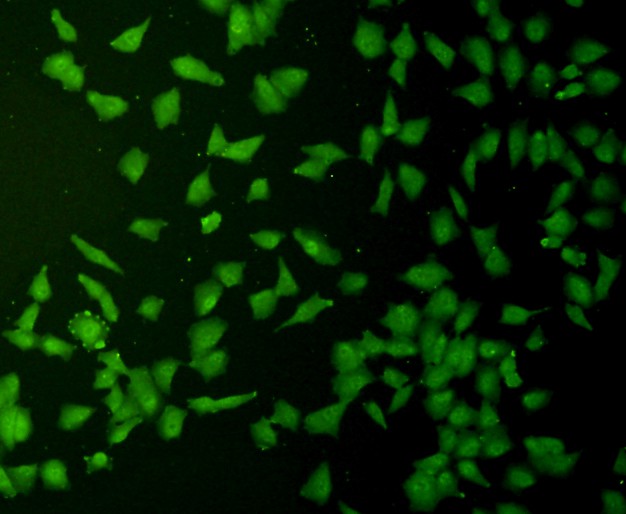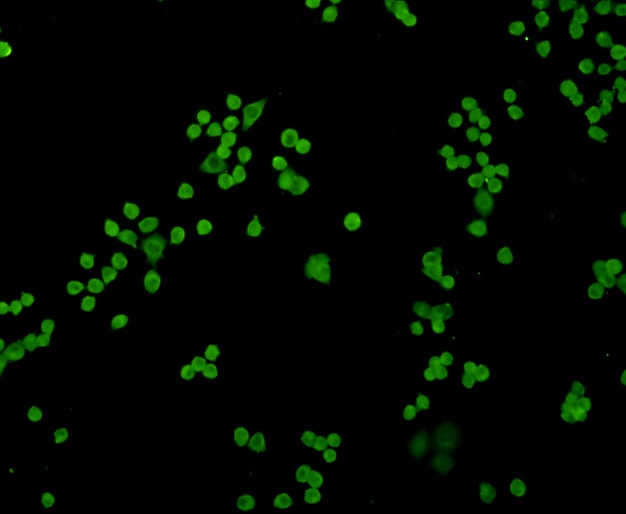Cyclin D1 Rabbit Polyclonal Antibody

cat.: 0407-27
| Product Type: | Rabbit polyclonal IgG, primary antibodies |
|---|---|
| Species reactivity: | Human, Mouse, Rat, Zebrafish |
| Applications: | WB, IF-Cell, FC |
| Clonality: | Polyclonal |
| Form: | Liquid |
| Storage condition: | Store at +4℃ after thawing. Aliquot store at -20℃. Avoid repeated freeze / thaw cycles. |
| Storage buffer: | 1*PBS (pH7.4), 0.2% BSA, 25% Glycerol. Preservative: 0.05% Sodium Azide. |
| Concentration: | 1ug/ul |
| Purification: | Immunogen affinity purified. |
| Molecular weight: | Predicted band size: 34 kDa |
| Isotype: | IgG |
| Immunogen: | This antibody is produced by immunizing rabbits with a synthetic peptide (KLH-coupled) corresponding to a region of C-terminal residues of cyclin D1. |
| Positive control: | MCF-7 lysates, A549, HepG2, N2A, A431. |
| Subcellular location: | Nucleus, Cytoplasm, Nucleus membrane. |
| Recommended Dilutions:
WB IF-Cell FC |
1:5,000 1:200 1:500-1:1,000 |
| Uniprot #: | SwissProt: P24385 Human | P25322 Mouse | P39948 Rat |
| Alternative names: | AI327039 B cell CLL/lymphoma 1 B cell leukemia 1 B cell lymphoma 1 protein B-cell lymphoma 1 protein BCL 1 BCL-1 BCL-1 oncogene BCL1 BCL1 oncogene ccnd1 cyclind1 CCND1/FSTL3 fusion gene, included CCND1/IGHG1 fusion gene, included CCND1/IGLC1 fusion gene, included CCND1/PTH fusion gene, included CCND1_HUMAN cD1 Cyl 1 D11S287E G1/S specific cyclin D1 G1/S-specific cyclin-D1 Parathyroid adenomatosis 1 PRAD1 PRAD1 oncogene U21B31 |
Images

|
Fig1: Western blot analysis of Cyclin D1 on MCF-7 lysate. Proteins were transferred to a PVDF membrane and blocked with 5% BSA in PBS for 1 hour at room temperature. The primary antibody was used at a 1:5,000 dilution in 5% BSA at room temperature for 2 hours. Goat Anti-Rabbit IgG - HRP Secondary Antibody (HA1001) at 1:5,000 dilution was used for 1 hour at room temperature. |

|
Fig2: ICC staining Cyclin D1 in A549 cells (green). Formalin fixed cells were permeabilized with 0.1% Triton X-100 in TBS for 10 minutes at room temperature and blocked with 1% Blocker BSA for 15 minutes at room temperature. Cells were probed with the antibody (0407-27) at a dilution of 1:200 for 1 hour at room temperature, washed with PBS. Alexa Fluorc™ 488 Goat anti-Rabbit IgG was used as the secondary antibody at 1/100 dilution. |

|
Fig3: ICC staining Cyclin D1 in HepG2 cells (green). Formalin fixed cells were permeabilized with 0.1% Triton X-100 in TBS for 10 minutes at room temperature and blocked with 1% Blocker BSA for 15 minutes at room temperature. Cells were probed with the antibody (0407-27) at a dilution of 1:200 for 1 hour at room temperature, washed with PBS. Alexa Fluorc™ 488 Goat anti-Rabbit IgG was used as the secondary antibody at 1/100 dilution. |

|
Fig4: ICC staining Cyclin D1 in N2A cells (green). Formalin fixed cells were permeabilized with 0.1% Triton X-100 in TBS for 10 minutes at room temperature and blocked with 1% Blocker BSA for 15 minutes at room temperature. Cells were probed with the antibody (0407-27) at a dilution of 1:100 for 1 hour at room temperature, washed with PBS. Alexa Fluorc™ 488 Goat anti-Rabbit IgG was used as the secondary antibody at 1/100 dilution. |

|
Fig5:
Flow cytometric analysis of A431 cells labeling Cyclin D1. Cells were fixed and permeabilized. Then stained with the primary antibody (0407-27, 1ug/ml) (red) compared with Rabbit IgG Isotype Control (green). After incubation of the primary antibody at +4℃ for an hour, the cells were stained with a iFluor™ 488 conjugate-Goat anti-Rabbit IgG Secondary antibody (HA1121) at 1/1,000 dilution for 30 minutes at +4℃. Unlabelled sample was used as a control (cells without incubation with primary antibody; black). |
Note: All products are “FOR RESEARCH USE ONLY AND ARE NOT INTENDED FOR DIAGNOSTIC OR THERAPEUTIC USE”.